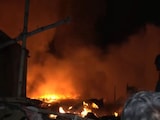The Natural History Museum's prestigious Wildlife Photographer of the Year (WPY) competition recently revealed extraordinary images that detail the profound environments and behaviours of creatures across the globe.
On Tuesday, American photographer Karine Aigner was announced as this year's winner of the grand title for her image called "The Big Buzz". Ms Aigner became only the fifth woman to win the top prize in the 58-year-old history of the competition. Her spectacular image captured a ball of mating male cactus bees frantically surrounding the sole female bee on a Texas ranch.
Speaking about the picture, Rosamund 'Roz' Kidman Cox, Chair of the Wildlife Photographer of the Year Jury, said, "Wings-whirring, incoming males home in on the ball of buzzing bees that is rolling straight into the picture. The sense of movement and intensity is shown at bee-level magnification and transforms what are little cactus bees into big competitors for a single female."
Karine Aigner won the Adult Grand Title Winner 2022.
The Young WPY for 2022, on the other hand, was awarded to Thailand's 16-year-old Katanyou Wuttichaitanakorn for his image called "Beauty of baleen". As per the official website, Mr Katanyou was on a whale tour boat when he photographed a whale's lunger-feeding technique to capture large numbers of small schooling fish and filter small prey from the ocean.
"Out of the jaws of a Bryde's whale comes this dazzling creation. The pin-sharp detail of the tiny anchovies is set against an abstraction of colour with the weave of brown baleen hair rimmed by a cascade of water drops," said Mr Cox.
Katanyou Wuttichaitanakorn won the Young Grand Title Winner 2022.
The WPY is one of the most prestigious competitions of its type in world photography. It is organised by London's Natural History Museum. This year, the competition attracted 38,575 entries from 93 countries.
Below are some of the category winners:
"The bat-snatcher" by Fernando Constantino Martinez Belmar won the Behaviour: Amphibians and Reptiles category.
"Shooting star" by Tony Wu won WPY's Underwater category.
This picture was captured off the coast of Japan. It shows a giant sea star, or Starfish, at the moment of spawning. "As the surrounding water filled with sperm and eggs from spawning sea stars, Tony faced several challenges. Stuck in a small, enclosed bay with only a macro lens for photographing small subjects, he backed up to squeeze the undulating sea star into his field of view in this galaxy-like scene," the description of the image read.
"House of bears" by Dmitry Kokh won the Urban Wildlife category.
Mr Kokh captured this picture on Kolyuchin Island, which is in the Arctic's Chukchi Sea. He spotted the polar bears roaming among the buildings of the long-deserted settlement. Mr Kokh used a low-noise drone to get close to the predators. His haunting picture won the Urban Wildlife category.
"The dying lake" by Daniel Nunez won the Wetlands, The Bigger Picture category.
Mr Nunez used a drone to capture the contrast between the forest and the algal growth on the edge of Guatemala's Lake Amatitlan. As per the description of the image, he took this photograph to raise awareness of the impact of contamination. "It was a sunny day with perfect conditions," Mr Nunez observed, "but it is a sad and shocking moment," he added.















